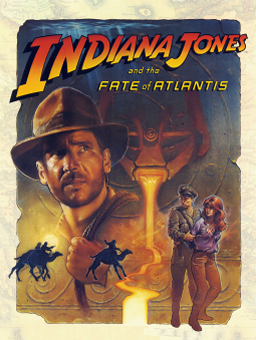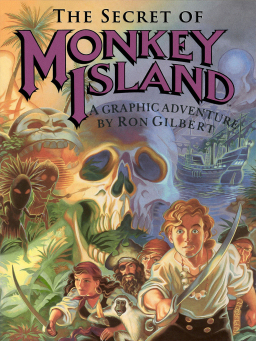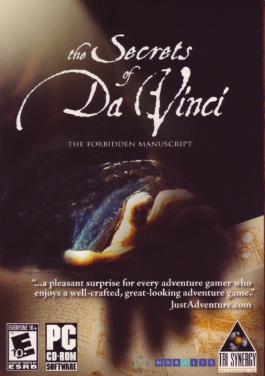
Simon the Sorcerer is a 1993 point-and-click adventure game developed and published by Adventure Soft, for Amiga and MS-DOS. The game's story focuses on a boy named Simon who is transported into a parallel universe of magic and monsters, where he embarks on a mission to become a wizard and rescue another from an evil sorcerer. The game's setting was inspired by the novels of the Discworld series, and incorporates parodies on fantasy novels and fairy tales, such as The Lord of the Rings and Jack and the Beanstalk. The lead character's design was inspired by that of the fictional British television character Blackadder, with the character voiced by Chris Barrie in the CD re-release.

Indiana Jones and the Fate of Atlantis is a point-and-click adventure game developed and published by LucasArts and released in June 1992 for Amiga, DOS, and Macintosh. Almost a year later, it was reissued on CD-ROM as an enhanced "talkie" edition with full voice acting and digitized sound effects. The seventh game to use the script language SCUMM, Fate of Atlantis has the player explore environments and interact with objects and characters by using commands constructed with predetermined verbs. It features three unique paths to select, influencing story development, gameplay and puzzles. The game used an updated SCUMM engine and required a 286-based PC, although it still runs as a real-mode DOS application. The CD talkie version required EMS memory enabled to load the voice data.

The Secret of Monkey Island is a 1990 point-and-click graphic adventure game developed and published by Lucasfilm Games. It takes place in a fictional version of the Caribbean during the age of piracy. The player assumes the role of Guybrush Threepwood, a young man who dreams of becoming a pirate, and explores fictional islands while solving puzzles.
Andrew Nicholas Oliver and Philip Edward Oliver, together known as the Oliver Twins, are British twin brothers and video game designers.

Beneath a Steel Sky is a 1994 point-and-click adventure game developed by British developer Revolution Software and published by Virgin Interactive Entertainment for MS-DOS and Amiga home computers. It was made available as freeware – and with the source code released – for PC platforms in 2003. Set in a dystopian cyberpunk future, the player assumes the role of Robert Foster, who was stranded in a wasteland known as "the Gap" as a child and adopted by a group of local Aboriginals, gradually adjusting to his life in the wilderness. After many years, armed security officers arrive, killing the locals and taking Robert back to Union City. He escapes and soon uncovers the corruption which lies at the heart of society.
The Elder Scrolls is a series of action role-playing video games primarily developed by Bethesda Game Studios and published by Bethesda Softworks. The series focuses on free-form gameplay in an open world. Morrowind, Oblivion and Skyrim all won Game of the Year awards from multiple outlets. The series has sold more than 58 million copies worldwide.

Gobliiins is a puzzle adventure video game series, consisting of five entries, released by Coktel Vision for the Amiga, Atari ST, DOS, and Macintosh platforms. The first three titles were released in the early 1990s, the fourth in 2009. The visual look of the series and its characters were created by French artist Pierre Gilhodes, whose style was used in another game from Coktel Vision: Woodruff and the Schnibble of Azimuth.
Dynamix, Inc. was an American developer of video games from 1984 to 2001, best known for the flight simulator Red Baron, the puzzle game The Incredible Machine, the Front Page Sports series, Betrayal at Krondor, and the online multiplayer game Tribes.
Simon the Sorcerer is a series of point-and-click adventure games created by British developer Adventure Soft. The series follows the adventures of an unwilling hero of the same name and has a strong fantasy setting similar to Sierra's King's Quest and Westwood's The Legend of Kyrandia series. The game varies in style, however, as it is more poised to be a parody of the fantasy genre than a member of the genre itself, with many renowned folklore characters appearing differently from what they are generally presumed to be.

Simon the Sorcerer II: The Lion, the Wizard and the Wardrobe is an adventure game created by Adventure Soft, and released in 1995 for the MS-DOS. It is the second installment in the Simon the Sorcerer series of games, and the sequel to 1993's Simon the Sorcerer. The game's story focuses on a young teen named Simon, who is transported into a parallel universe of magic and monsters that he visited before, via a magical wardrobe created by an evil sorcerer he defeated in the last game. Players engage in a quest to help him find more fuel for the wardrobe by searching a vast world, consisting of parodies on popular fantasy novels and fairy tales.

King's Quest VI: Heir Today, Gone Tomorrow is a point-and-click adventure game, first released in 1992 as the sixth installment in the King's Quest series produced by Sierra On-Line. Written by Roberta Williams and Jane Jensen, King's Quest VI is widely recognized as the high point in the series for its landmark 3D graphic introduction movie and professional voice acting. King's Quest VI was programmed in Sierra's Creative Interpreter and was the last King's Quest game to be released on floppy disk. A CD-ROM version of the game was released in 1993, including more character voices, a slightly different opening movie and more detailed artwork and animation.

Runaway: A Road Adventure is a 2001 graphic adventure game developed by the Spanish company Pendulo Studios and published by Dinamic Multimedia. It follows the story of Brian Basco, an American college student on the run after he unwittingly saves a murder witness named Gina Timmins from assassination by the New York Mafia. Searching for clues about a mysterious crucifix linked to the murder, Brian and Gina embark on a cross-country journey through the United States while pursued by two Mafia hitmen. The player assumes the role of Brian and explores the game world while collecting items, solving puzzles and conversing with non-player characters.

Leisure Suit Larry in the Land of the Lounge Lizards is a graphic adventure game, developed by Sierra On-Line, and published in 1987. It was developed for the PC, DOS, and the Apple II and later ported to other platforms, such as the Amiga, Atari ST, Apple IIGS, Macintosh, and Tandy Color Computer 3. It utilizes the Adventure Game Interpreter (AGI) engine. In 1991, Sierra released a remake titled Leisure Suit Larry 1: In the Land of the Lounge Lizards for PC DOS, Apple Macintosh, and Amiga. This version used the Sierra's Creative Interpreter (SCI) engine, featuring 256 colors and a point-and-click, icon-driven user interface.

Curse of Enchantia is a graphic adventure game developed and released by the British video game company Core Design for MS-DOS and the Amiga in 1992. The game tells the comic fantasy story of Brad, a teenage boy from modern Earth who was magically abducted to the world of Enchantia by an evil witch-queen. He needs to escape and find a way back to his own dimension.

Nightlong: Union City Conspiracy is a cyberpunk-themed adventure game developed by Trecision and Team17 and published by MicroProse in Europe and DreamCatcher Interactive in North America. It was later ported to the Amiga by ClickBOOM.

Dracula: Origin is a point-and-click adventure game for the PC based on the novel Dracula by Bram Stoker. Released by Frogwares in 2008, it follows the company's catalogue of adventure games such as the Adventures of Sherlock Holmes series.

Limbo is a puzzle-platform video game with horror elements developed by independent studio Playdead and originally published by Microsoft Game Studios for the Xbox 360. The game was released in July 2010 on Xbox Live Arcade, and has since been ported by Playdead to several other systems, including the PlayStation 3, Linux and Microsoft Windows. Limbo is a 2D side-scroller, incorporating a physics system that governs environmental objects and the player character. The player guides an unnamed boy through dangerous environments and traps as he searches for his sister. The developer built the game's puzzles expecting the player to fail before finding the correct solution. Playdead called the style of play "trial and death", and used gruesome imagery for the boy's deaths to steer the player from unworkable solutions.
An adventure game is a video game genre in which the player assumes the role of a protagonist in an interactive story, driven by exploration and/or puzzle-solving. The genre's focus on story allows it to draw heavily from other narrative-based media, such as literature and film, encompassing a wide variety of genres. Most adventure games are designed for a single player, since the emphasis on story and character makes multiplayer design difficult. Colossal Cave Adventure is identified by Rick Adams as the first such adventure game, first released in 1976, while other notable adventure game series include Zork, King's Quest, Monkey Island, Syberia, and Myst.

The Lost Vikings is a puzzle-platform game developed by Silicon & Synapse and published by Interplay. It was originally released for the Super NES in 1993, then subsequently released for the Amiga, Amiga CD32, MS-DOS, and Mega Drive/Genesis systems; the Mega Drive/Genesis version contains five stages not present in any other version of the game, and can also be played by three players simultaneously. Blizzard re-released the game for the Game Boy Advance in 2003. In 2014, the game was added to Battle.net as a free download emulated through DOSBox. In celebration of the company's 30th anniversary, The Lost Vikings was re-released for Microsoft Windows, Nintendo Switch, PlayStation 4 and Xbox One as part of the Blizzard Arcade Collection in February 2021.

The Secrets of Da Vinci: The Forbidden Manuscript is an adventure game developed by Kheops Studio and published by Tri Synergy on June 7, 2006 on the PC. In 2009 it was released on the Mac OS X.















